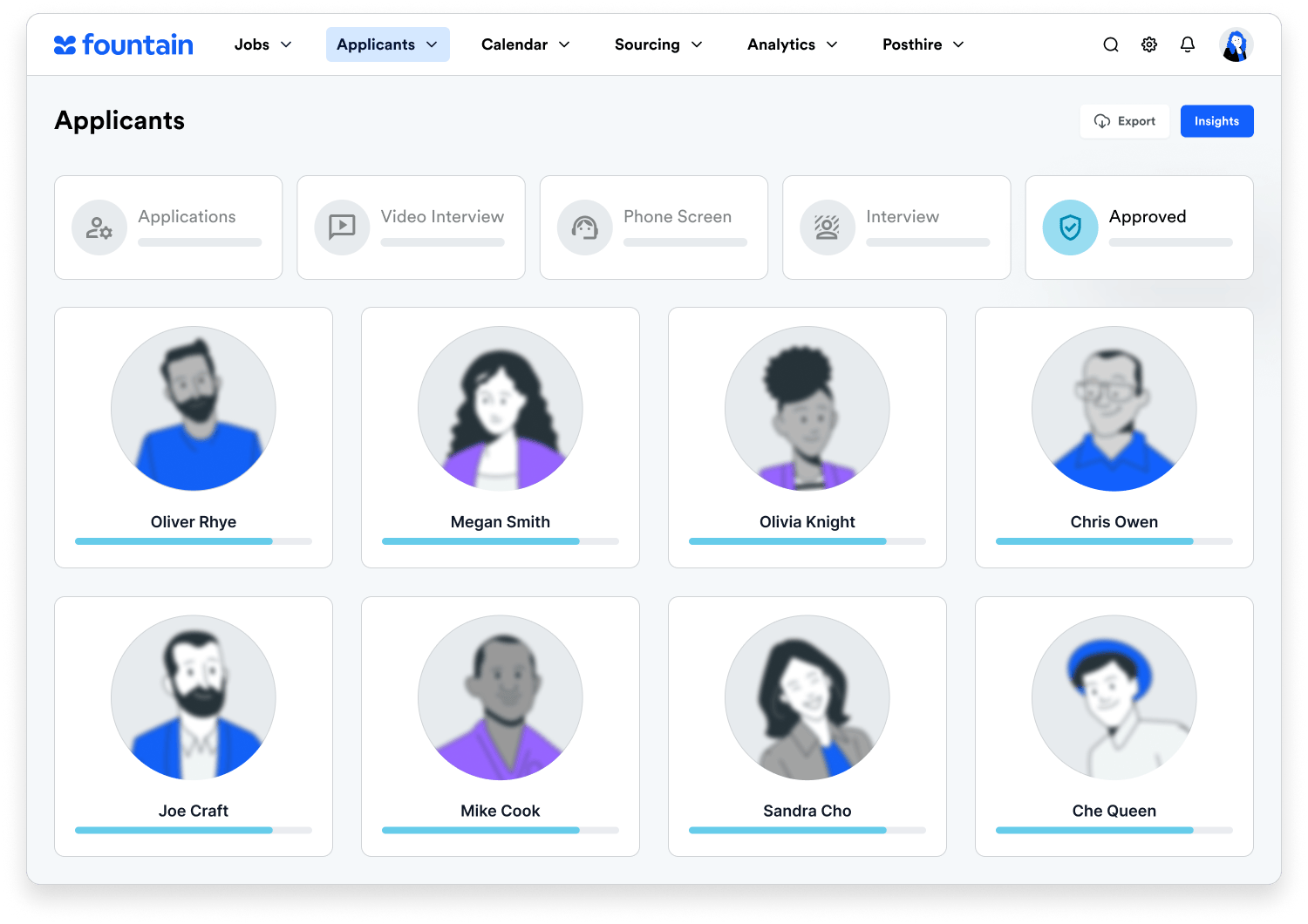Here we’ll be taking a deeper look into some of the trends we’re seeing across users on the Fountain Platform.
High-Level Benchmarks
Here are some of the key candidate data points we saw in 2019 across all Fountain customers:
- Conversions were 12.32%. This means that about 1 out of every 8 candidates that applied to a job ended up getting hired.
- Time-to-hire averaged around 7.5 days
The Fountain platform breaks down your hiring process into discrete stages, allowing you to set a repeatable and effective process. A stage can consist of an email, phone call, request for insurance, etc. Anything involving a candidate touchpoint. Here are some of the key averages we saw around stages last year:
- 16.8 stages per active opening
- 2.3 rules per active opening
- 3.2 data collection stages per active opening
Another question every Talent Acquisition wants to know is how many applicants a recruiter can process. Understanding this will help you properly allocate resources on your team, so you’re not overloading your recruiters with too many positions.
Something to keep in mind is that not all roles are created equal. For example, corporate recruiters that are hiring more specialized positions aren’t going to be able to handle nearly the quantity of applicants the high-volume hourly recruiters are processing. We broke down the applicant to user ratio by yearly applicants:
- >1,000,000 = 2565:1
- 100,000-1,000,000= 1215:1
- 10,000-100,000 = 525:1
What you see here is that as you scale up your candidate pool, your recruiters are then able to process more applications.
Trends in the Marketplace
All of these metrics vary across countries and industries. In 2019, these were the top 10 countries processing applicants on the Fountain platform, and their hire rates.
- USA, 12.5%
- UK, 14.5%
- France, 7.0%
- Saudi Arabi, 14.1%
- Taiwan, 6.7%
- Brazil, 23.5%
- Chile, 13.7%
- Argentina, 16.2%
- Colombia, 17.2%
- Germany, 6.3%
The United States has by far our highest user base, so it makes sense that they average out close to the 12.32% hire rate. We can also see that countries in continental Europe (Germany, France) have much lower hire rates, possibly due to the regulatory environment or differences in labor. Here are some of the breakdown rates by industry:
- Rideshare, 19.5%
- Petcare & personal, 16.5%
- Staffing, 16.3%
- Couriers, 12.2%
- Scooter/bike share, 13.0%
- Food delivery, 10.9%
- Children/elderly care, 5.9%
Understandably, childcare is going to be one of the lowest hire rates. Not everyone is equipped to properly watch and care for another’s child, and the vetting process is going to be far more thorough than someone handling scooter services.
The Ideal Workflow
The ideal workflow is a repeatable process that we’ve seen be successful across industries for high-volume recruiting.
- Application → Review → Onboarding → Posthire
The application stage should be as automated as possible, where candidates are filling out forms and answering qualifying questions. The review stage is a manual interaction with your team, where they’re looking over and vetting profiles to make sure they’re a fit with the role. The onboarding process should also be automated, whether its sending gear, training, or filling out paperwork, remove as many manual steps as you can. If a candidate doesn’t get past the review stage, it’s important to be sending polite rejection messages. Post-hire will also be automated and involves continuous learning and document signing.
Workflow Insights
Interviewing
We’ve started looking at stage insights on a macro level. After having conversations with customers around the best practices for interviewing, we now have data that helps us really understand what to be advising.
- Video Recording, 69.6% conversion
- Time in stage: 2.5 Hours
- Scheduler Stage, 68.6% conversion
- Time in stage: 3 Days
You can often know within the first 3-4 minutes whether or not a candidate is a good fit, so it’s possible you’re wasting an additional 15 minutes on a call with an unqualified candidate to be polite. While the conversion rate for calls and pre-recorded videos are similar, you can see that the average time spent in the stage for calls is much longer. Video recordings also allow you to see the mannerisms of candidates, and you can conduct the review of these on your own time.
Follow-ups
We were interested to know how adding additional follow-ups would affect the conversions of your applicants.
- 1 follow-up (after 1 day): +3%
- 2 follow-ups (after 2 days): +6%
- 3 follow-ups (after 3 days): +9%
The data shows that each additional follow-up increased conversions by 3%. This indicates that applicants do respond to follow-up messages with completion.
Key Takeaway
A lot of recruiters understand their individual metrics for their roles and accounts, but oftentimes we neglect the data on the candidate side.
It’s crucial to understand how each stage is affecting your conversions. Once you understand how they’re being affected, you can implement changes to increase those rates.

